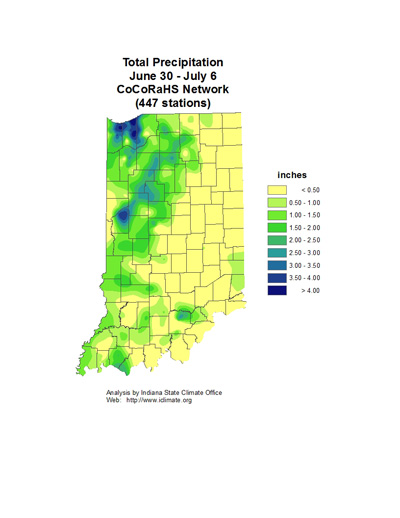- Trochanter Mealybug: Perhaps a Reason for Yellowing of Soybeans
- Black Light Trap Catch Report
- Western Corn Cutworm Adult Pheromone Trap Report
Trochanter Mealybug: Perhaps a Reason for Yellowing of Soybeans - (Christian Krupke and John Obermeyer)
It has been a couple of years since last mention, but the trochanter mealybug is still on the radar. This was first found in Indiana in 2009, though we have not had any reports since.
These are insects in the same group as aphids – plant-sucking, relatively sedentary creatures. Similar to other mealybugs in appearance, these small, whitish insects live beneath the soil surface and feed on plant juices. The above-ground symptoms are similar to K-deficiency – yellowing of foliage and stunting. If you have soybeans that exhibit these symptoms, we would recommend digging them up and inspecting for the whitish crawlers seen attached to the roots. Shaking the roots over dark-colored paper will make them more visible and the grayish-white insects will soon begin crawling around the paper. A hand lens may be required to confirm diagnosis.
Potassium deficiency symptoms could be a sign of mealybugs below (Photo credit: Ohio State University
Mealybugs, white fluffy mass on the soybean root
If you have the yellowing foliage and stunting symptoms in soybeans and think you have mealybugs, please let us know – we are hoping to obtain samples from around the state to find out the range and extent of this insect in Indiana.
Close-up of mealybugs on soybean root
Ron Hammond and Andy Michel at Ohio State are leading a project to find out more about these insects in our area (eastern corn belt) and determine their role as a potential pest. Interesting questions include whether they are a primary cause of the yellowing, or are they attacking previously-stressed plants? We are hoping to get an idea of how common these insects are throughout the state, and whether geography, soil type, maturity etc., play significant roles. Please contact us (ckrupke@purdue.edu or obe@purdue.edu if you have fields that may be candidates for this project.
![]()
Click here to see the Black Light Trap Catch Report
![]()
Click here to see the Western Bean Cutworm Adult Pheromone Trap Report
![]()
Soybean Early Reproductive Growth Stages - (Shaun N. Casteel)
Soybean development in Indiana ranges from just planted to flowering. As of the 3rd of July, 94% of the soybeans had emerged and 3% were blooming. The rate of bloom is about 10% less than the 5-year average and 20% less than last year's fast pace. Management decisions are based on the growth stage, the time of the year, and pest (weeds, insects, disease) occurrence. We will overview the early reproductive stages of soybean for proper scouting.
Reproductive Growth Stages:
R1 – Beginning Bloom is defined as any open flower(s) on any of the main stem nodes. Flowering normally begins at the third to sixth main stem node (including the cotyledon and unifoliate nodes). A node is the point where the lateral leaf branch attaches to the main stem. It will form a bump, which is helpful in determining the nodes of the cotyledons and the unifoliates. Cotyledons and unifoliates eventually abscise as vegetative growth progresses up the plant. These nodes will have a bump on opposite sides of the stem followed by alternating nodes of the trifoliates (see R1 picture). Flowering begins around six to eight weeks after emergence and it is both temperature and photoperiod responsive. Vertical root growth rate increases rapidly. Approximately 65 days away from the beginning of physiological maturity (R7).
Cotyledon Node
The R1 soybean pictured has six trifoliates. The first flower was initiated at trifoliate node 2, which is node 4 when cotyledon and unifoliate nodes are included. This plant would be classified as V6 (vegetative stage 6) if there was no open flowers on the main stem.
R2 – Full Bloom is where any open flower is located at one of the two upper most nodes of the main stem. Plant has accumulated~25% of the total dry weight and ~50% of the total node number. Rapid dry weight and nutrient accumulation begins and continues until physiological maturity. Nitrogen fixation rate increases as does the plant's nitrogen demand. Approximately 60 days away from the beginning of physiological maturity (R7).
R2: Full Bloom
| Growth Stage | Duration Median | Duration Range |
| # of Days | ||
| R1: Beginning Bloom | 4 | 1 to 7 |
| R2: Full Bloom | 10 | 5 to 15 |
| R3: Beginning Pod | 10 | 5 to 15 |
| R4: Full Pod | 10 | 4 to 26 |
| R5: Beginning Seed | 15 | 11 to 20 |
| R6: Full Seed | 20 | 9 to 30 |
R3: Beginning Pod
R3: Full Pod
![]()










